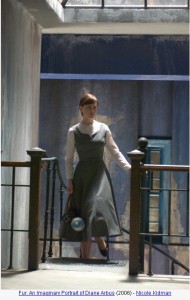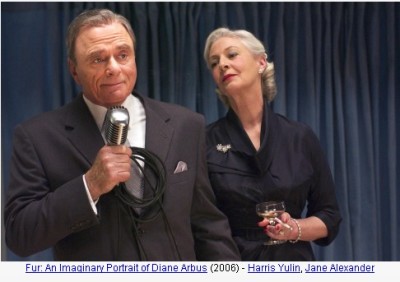By: debbie lynn elias
The fragility of life, the fragility of love, the fragility of self and the inherent beauty therein. Such is FUR: AN IMAGINARY PORTRAIT OF DIANE ARBUS.

Diane Arbus (pronounced Dee-Ann) is one of the most prolific and legendary photographers of our time. Born in 1917 to a wealthy Jewish family of furriers, her life is a storied one. Her brother, poet Howard Nemerov. At age 14, she met and fell in love with actor Allan Arbus whom she ultimately married 4 years later against her parents vehement objections. Arbus, a photographer who began his career doing photos while in the military, eventually started his own studio (apparently with some help from the Nemerovs) and with Diane and her impeccable taste and sense of style, eventually became the toast of fashion world photography. Arbus, clearly smitten with Diane’s keen eye, shepherded her with rudimentary instruction in photography. But it wasn’t until some years later, that her own artistic desire and curiosity took hold, propelling her into a fantastical world of visionary delight. But what was it that pushed her into her own? Known for her provocative and evocative works of what many may deem to be unusual subjects or even freaks (take for example possibly her most famous photographer of Eddie Carmel, “The Jewish Giant” or “Identical Twins” – a photo mimicked on film in Stanley Kubrick’s “The Shining” and which is the seventh highest selling photo of all time) FUR hypothesizes as to what unleashed the artist within, what compelled her, what fueled her obsession with the unique and unusual. Based on the biography by Patricia Bosworth and extensive interviews with Arbus family members and friends of Diane, screenwriter Erin Cressida Wilson gives us a spellbinding romanticized tale of an enigmatic and very private talent.

The time is 1958. Diane Arbus is the epitome of prim and proper high society. Picture perfect, her home, her children, her lifestyle, are as idealized as that depicted in her husband’s photographs. Dutiful and mindful of her obligations and societal status, it is clear that this public Diane is not the real Diane. The world sees what she wants it to see or what it chooses to see – as if her life is no more than a posed photograph. With glimpses of her self-eroticism and fantasy, as she knows, so do we – there is more to Diane than meets the eye. Her fantasies and curiosities, however, soon bubble forth as a new tenant arrives at the brownstone in which the Arbuses live and work.
Swathed in clothing from head to toe with a burlap mask covering his face, Diane is mesmerized and spellbound with curiosity over this masked man. Peering out the window through a slit in the window curtains, her wonder is evident as odd looking, yet richly textured and colorful furnishings arrive. Even this man in his mysterious garb has eye-catching touches of color and texture – not at all like the satin finished pastel sheen of Diane’s life.
In one bold move, Diane ultimately sneaks out of the house late in the evening. Putting on a vivid blue eyelet dress with her unused Rolleiflex camera suspended from her neck, Diane makes a trepidatious ascent to the upper floor of the building. Her ruse is well planned. Photos. She wants to take the tenant’s photo. As she climbs higher and higher, the class distinctions become more obvious. With each floor she climbs, wallpaper peels and paint chips revealing layers of lives that had come before – and all so much richer, vivacious and electric than the pale pastels of Diane’s world. Ultimately, Diane reaches the door. You can feel her nervous sweat. The tingle of excitement. Eyeing the tenant through the golden peephole, she is invited into his home.
What Diane sees is not to be believed. A fantastical world. Lush, textured, alive and yet with all the propriety of high society. Tea in china cups. A man in a meticulously tailored suit. Impeccable posture. Pinkies extended. Perfect elocution in his speech. A home filled to the brim with life. Crowded but comfortable. But, Diane hasn’t seen it all – not yet. With eyes covered, she is led to a Roman or Turkish bath in the home. Slowly she descends into the waters as if a baptismal. And then she sees Lionel. Covered in hair from head to toe, Lionel suffers from hypertrichosis. Although one might expect to be repelled at the site of Lionel, neither Diane nor the audience, is. Rather, all are drawn to him. There is a comfortable yet erotically compelling mysticism about him. And that is all it takes for Diane to embark on her journey of self-exploration, self-expression and love.
Set against a backdrop of intimate late night gatherings between the two, like looking through the lens of a camera, we are privy to the blossoming of not only a forbidden love, but a forbidden life. Ah, but Lionel. Lionel brings Diane to life. By sharing his life, she begins to live hers. Drawing closer to Lionel and further from her husband, she tries to bring the two worlds together, making the two parts into a whole as she becomes whole. Her narrow focal point is soon no more as the aperture of her life grows ever wider. And of course, at the root of it all is love and passion.

Not one to be a spoiler, I will divulge no more of the story as it is something to be experienced first-hand. It cannot be told. It needs to be seen.
Nicole Kidman takes on the daunting task of playing a very real person with a perspective built on fact and fiction. It is a precarious balancing act to be sure, but Kidman embraces the petite, introverted, obedient, recessive Diane with a tacitly compelling strength and curiosity. With the unbridled joy of newborn colt, once exposed to Lionel’s world, she has an expressive wide-eyed wonderment that is captivating and contagious. Yet, at the same time, her sensuality is undeniable – especially when interacting with Robert Downey, Jr.’s Lionel. And I have to say, words fail me in describing Downey’s performance. This is the finest performance of his career and demands attention from Oscar. Either covered in hair or swaddled in masks and head-to-toe clothing, his eyes and lips speak volumes. As the story progresses and we learn more about Lionel, there is a vulnerability underlying his conviction of character that is undeniable. Exuding a confident softness, he erotically romantic, hypnotic even. Spellbinding. Absolutely mesmerizing. It is impossible to take your eyes from the screen when Kidman and Downey are together. Their performances are captivatingly laced with a romantic and sensual eroticism that grows into an explosive, passionate once-in-a-lifetime love. This is their film but particularly that of Robert Downey, Jr. He has never been better.
Not to overlook the supporting players, Ty Burrell is stellar as Allan Arbus. Talented, harried and totally reliant on his wife, it is enjoyable to watch the transformation of this 1950’s man-of-the-family as he realizes he is not the king of the castle and he cannot make it on his own. Burrell gives us a man who despite realizing his shortcomings and failings, still tries to be “the man”, but without admitting he should have been looking at life and Diane through a wide-angle lens. Jane Alexander and Harris Yulin are ideal as Diane’s parents. Always a woman of strength and character, Jane Alexander epitomizes the 50’s high society matriarch.

Screenwiter Erin Cressida Wilson reteams with “Secretary” partner, director Steven Shainberg, giving us a winning one-two punch combination. The dialogue is well written, nay, well crafted, and particularly witty and sly where Lionel is concerned. From the opening shot of Diane Arbus swathed in a uniquely looking fur coat with Rolleiflex camera slung around her neck walking up to the gates of a nudist colony, your own hairs stand on end with excitement and wonder. The development of the characters is pointed and well-timed, exposing intimate details and secrets of each within each frame of the film. Capitalizing on Arbus’ own photographic works and her uniquely individualized viewpoint of her subjects, Shainberg and Wilson’s “imaginary portrait” more than fills the imagination. Arbus’ own works voyeuristic, we are treated as voyeurs to Arbus’ life and more importantly, her heart.
Concentrating on visuals, the photographic references are undeniable. Everything is seen through a lens. The eyelet of the fabric of Diane’s dress that seemed to be the one most worn during her visits with Lionel, the peepholes on front doors – Lionel’s wide enough to see more than an eye and viewable in and out while the Arbus’ a typical one-way “fish eye”. Color and texture, so rich and deep in Lionel’s world, are enhanced thanks to the cinematography of the legendary Bill Pope. Perhaps the only other cinematographer who could achieve the same effects as Pope is Eduardo Serra. Using the furnishings and textures of Lionel’s home as lenses or frames in and of themselves, so much of the film is shot through a chair rail, or angled behind a chair or through a door or window. They say eyes are the windows to the soul. So is the camera lens.
Amy Danger, who teamed with Shainberg on “Secretary” comes on board again as production designer. Clearly, her research was impeccable and the juxtapositioning of worlds through Carrie Stewart’s set design and Mark Bridges’ costuming is flawless. And of course, kudos, kudos, kudos to Stan Winston Studios for their work with Robert Downey, Jr. as Lionel. The head to toe fur is beyond realistic and despite the medical oddity of the character’s condition, believable.
Surprising. Spellbinding. Sensual. Mesmerizing. I am totally and completely impressed and intrigued. A beautiful love story. A wonderful fantasy. Love and life come from the most unexpected places. Here, it is with FUR: AN IMAGINARY PORTRAIT OF DIANE ARBUS.
Diane Arbus: Nicole Kidman
Lionel Sweeney: Robert Downey, Jr.
Allan Arbus: Ty Burrell
Gertrude Nemerov: Jane Alexander
David Nemerov: Harris Yulin
Directed by Steven Shainberg. Written by Erin Cressida Wilson based on the book “Diane Arbus” by Patricia Bosworth. Rated R.












